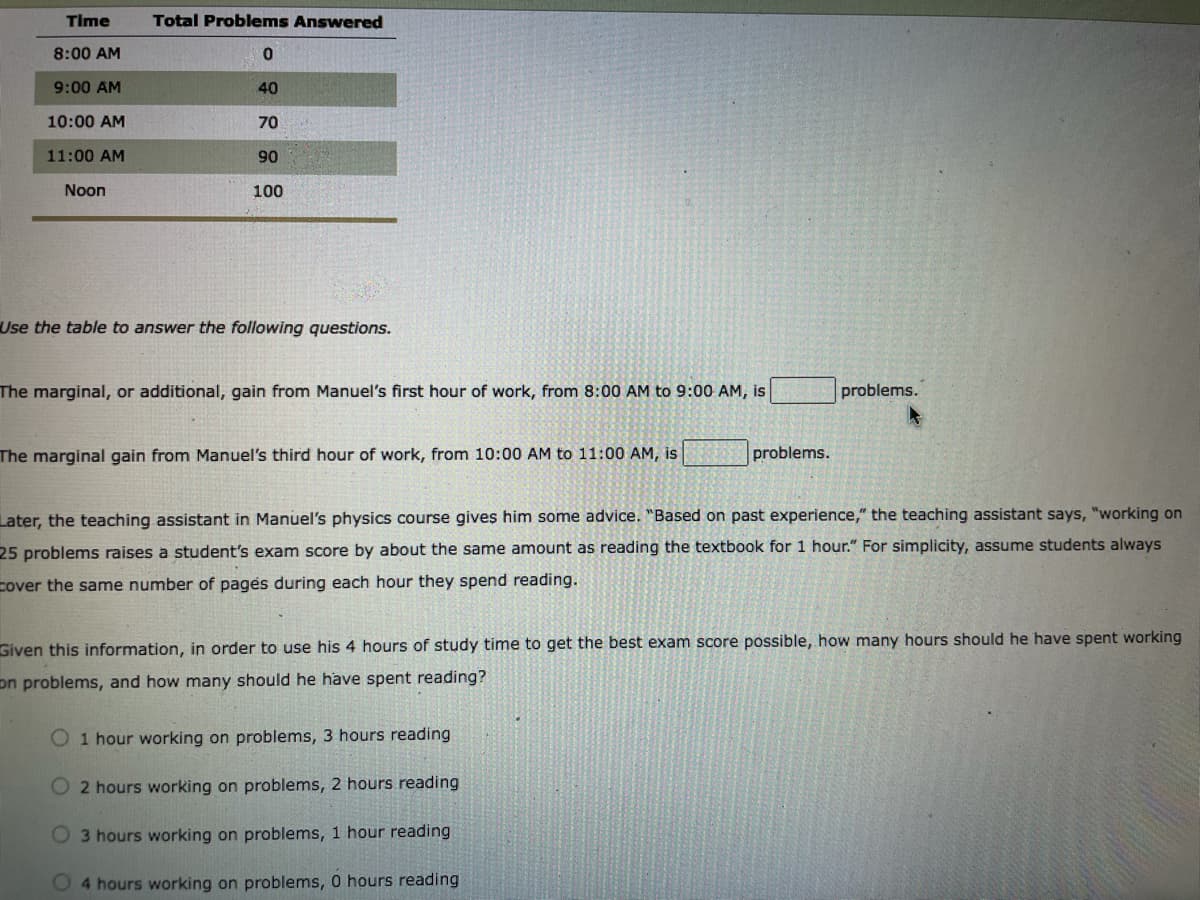10:00 AM 70 11:00 AM 06 100 Noon Use the table to answer the following questions. The marginal, or additional, gain from Manuel's first hour of work, from 8:00 AM to 9:00 AM, is problems. The marginal gain from Manuel's third hour of work, from 10:00 AM to 11:00 AM, is problems. Later, the teaching assistant in Manuel's physics course gives him some advice. "Based on past experience," the teaching assistant says, "worki 25 problems raises a student's exam score by about the same amount as reading the textbook for 1 hour." For simplicity, assume students alw. cover the same number of pages during each hour they spend reading. Given this information, in order to use his 4 hours of study time to get the best exam score possible, how many hours should he have spent w on problems, and how many should he have spent reading? O 1 hour working on problems, 3 hours reading O 2 hours working on problems, 2 hours reading O 3 hours working on problems, 1 hour reading O 4 hours working on problems, 0 hours reading
10:00 AM 70 11:00 AM 06 100 Noon Use the table to answer the following questions. The marginal, or additional, gain from Manuel's first hour of work, from 8:00 AM to 9:00 AM, is problems. The marginal gain from Manuel's third hour of work, from 10:00 AM to 11:00 AM, is problems. Later, the teaching assistant in Manuel's physics course gives him some advice. "Based on past experience," the teaching assistant says, "worki 25 problems raises a student's exam score by about the same amount as reading the textbook for 1 hour." For simplicity, assume students alw. cover the same number of pages during each hour they spend reading. Given this information, in order to use his 4 hours of study time to get the best exam score possible, how many hours should he have spent w on problems, and how many should he have spent reading? O 1 hour working on problems, 3 hours reading O 2 hours working on problems, 2 hours reading O 3 hours working on problems, 1 hour reading O 4 hours working on problems, 0 hours reading
Microeconomics: Principles & Policy
14th Edition
ISBN:9781337794992
Author:William J. Baumol, Alan S. Blinder, John L. Solow
Publisher:William J. Baumol, Alan S. Blinder, John L. Solow
Chapter8: Output, Price, And Profit: The Importance Of Marginal Analysis
Section8.A: Appendix The Relationships Among Total, Average, And Marginal Data
Problem 1TY
Related questions
Question

Transcribed Image Text:Time
Total Problems Answered
8:00 AM
9:00 AM
40
10:00 AM
70
11:00 AM
90
Noon
100
Use the table to answer the following questions.
The marginal, or additional, gain from Manuel's first hour of work, from 8:00 AM to 9:00 AM, is
problems.
The marginal gain from Manuel's third hour of work, from 10:00 AM to 11:00 AM, is
problems.
Later, the teaching assistant in Manuel's physics course gives him some advice. "Based on past experience," the teaching assistant says, "working on
25 problems raises a student's exam score by about the same amount as reading the textbook for 1 hour." For simplicity, assume students always
cover the same number of pages during each hour they spend reading.
Given this information, in order to use his 4 hours of study time to get the best exam score possible, how many hours should he have spent working
on problems, and how many should he have spent reading?
O 1 hour working on problems, 3 hours reading
O 2 hours working on problems, 2 hours reading
O 3 hours working on problems, 1 hour reading
O 4 hours working on problems, 0 hours reading
Expert Solution
Step 1
Marginal gain is the additional gain that an individual gets from having one more unit of a good or service.
Trending now
This is a popular solution!
Step by step
Solved in 2 steps

Knowledge Booster
Learn more about
Need a deep-dive on the concept behind this application? Look no further. Learn more about this topic, economics and related others by exploring similar questions and additional content below.Recommended textbooks for you

Microeconomics: Principles & Policy
Economics
ISBN:
9781337794992
Author:
William J. Baumol, Alan S. Blinder, John L. Solow
Publisher:
Cengage Learning

Exploring Economics
Economics
ISBN:
9781544336329
Author:
Robert L. Sexton
Publisher:
SAGE Publications, Inc

Principles of Economics 2e
Economics
ISBN:
9781947172364
Author:
Steven A. Greenlaw; David Shapiro
Publisher:
OpenStax

Microeconomics: Principles & Policy
Economics
ISBN:
9781337794992
Author:
William J. Baumol, Alan S. Blinder, John L. Solow
Publisher:
Cengage Learning

Exploring Economics
Economics
ISBN:
9781544336329
Author:
Robert L. Sexton
Publisher:
SAGE Publications, Inc

Principles of Economics 2e
Economics
ISBN:
9781947172364
Author:
Steven A. Greenlaw; David Shapiro
Publisher:
OpenStax


